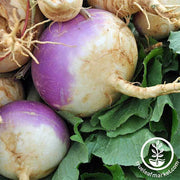Turnip Seeds - Purple Top White Globe
50-60 days. Purple Top White Globe Turnip Seeds. Brassica rapa subsp. rapa. Non-GMO. Open Pollinated. Purple Top White Globe Turnip seeds grow into cool season root vegetables that are hardy biennials. These bulb-shaped plants are one of the most diverse veggies, as turnips are in the brassicae category and have many varieties within its family. All turnips produce edible leaves and roots, making Purple Top White Globe seeds a gardener's dream to grow! 1 lb - Wholesale - Approximately 192,000 Seeds
Growing Non-GMO Purple Top White Globe Turnip Vegetable Seeds
How to Grow Purple Top White Globe Turnip from Seed
Turnip is a cool-season vegetable sown 3-4 weeks before final spring frost or mid-late summer to allow maturing plants cooler fall weather for harvesting. Like other root vegetables, turnip does not transplant well and should always be directly sown. Plant 2-3 seeds 1/2" deep and 1-2" apart in Organically composted, well-tilled, and well-drained soil with a pH of 6.0-7.5.
Turnip seeds germinate in 3-10 days, thin out healthiest starts to every 4-6" in the garden as true leaves establish. Turnip seeds thrive with a top layer of mulch to help cool soil and roots. Unlike other root vegetables, turnip benefits from a nitrogen-rich fertilizer during vegetative growth.
Purple Top White Globe Turnip in the Vegetable Garden
Turnip is one of the unsung heroes of the garden bed along with rutabaga, kohlrabi, and celeriac. One of the rare root crops whose leafy greens might be more popular than the root itself, tender turnip greens are able to be harvested well into fall similar to spinach or collards. Most varieties of turnip are ready to harvest in about 50 days when bright purple roots begin to show, but always taste best if harvested after a light frost or two.
Brassica rapa subsp. rapa varieties are native to the eastern and mid-regions of Asia. Turnips are hardy biennials in the mustard family. This plant category of cool season root veggies were first cultivated in Europe during the 16th century, where turnips predated potato crops in places like England.
Harvesting Purple Top White Globe Turnip
Harvest Purple Top White Globe Turnips 55 days from the sowing date or once the roots have grown 4" wide. It's recommended to pick biennial turnips sooner than later, as their smaller bulb size contains more flavor. Generally, turnips are fast-growing. Be sure to keep an eye on their size. Harvest root vegetables by lifting up the roots with a gardening fork or by digging up the entire plant. You can also harvest the peppery and edible green leaves of turnips once they've grown 3" wide. Don't cut more than 3 leaves off at a time.
Depending on variety, turnip is ready for harvest about 40-70 days from sowing or when roots begin pushing up and showing 3-4" diameter above soil. Turnip greens are just as popular as the turnip root and can be quickly harvested while still young and tender during root production. Turnips are shallow-rooted and can be harvested from the ground like a potato or radish by firmly pulling out of the soil. If possible, harvest after the first autumn frost for best flavor.
About Purple Top White Globe Turnip Seeds
Brassica rapa subsp. rapa. (50-60 Days)
Purple Top White Globe Turnips make a healthy alternative to savory dishes we find appetizing, such as potatoes. Many gardeners dream about when they can grow their next heirloom crop, as sweet and smooth flavor comes from the turnips" roots.
As one of the oldest and most diverse culinary treats, turnips also take on a heartiness similar to carrots when they're cooked with garlic or rosemary.
1881 D.M. Ferry Catalog says about American Purple Top Turnip Seeds...
"A variety of the purple top flat turnip, from which it originated. We are inclined to think that this new variety will in time be as largely used as the purple top flat turnip is now. It is globular in form, and quite as large as the Pomeranean White Globe, of beautiful appearance, of most excellent quality, and equally desirable for table or stock. It is undoubtedly a fine market sort, and keeps well."
1927 Burrell's Seed Catalog says about American Purple Top Turnip Seeds...
"This excellent table variety is globular in shape, of good size and very attractive appearance. The roots are large, purple or dark red above the ground, white below. The flesh is white, fine grained and tender. The roots, when in best condition for the table, are about 3 inches in diameter, but can be grown much larger for stock feeding. This sort keeps well for so early a variety and is one of the best for market use. Sometimes known as Red Top White Globe."
1935 Isbell's Seed Co. catalog says about American Purple Top Turnip Seeds...
"One of the handsomest and most salable turnips. Desirable for either home or market. Large, rapid-growing sort, with globular-shaped roots, under portion being white and top bright purple. Flesh pure white, fine grained and of fine flavor. Sure cropper and splendid keeper. Grown extensively here in Michigan as well as in most other sections; a heavy yielder. Ready to use in 65 days."
American Purple Top Turnip Seeds is recommended by the Following State Universities or Ag Extension Offices as a variety that performs well for their region. FL, OR, TX
Basic Info
| Latin Name: | Brassica rapa subsp. rapa |
| Purple Top White Globe Color: | Radiant purple root tops and white base beneath the soil |
| Purple Top White Globe Flavor: | Sweet, smooth, hearty with mild pepper |
Growing Info
| Hardiness Zone: | Annual 2-9 |
| Days to Maturity: | 50-60 |
| Days to Germination: | 3-10 |
| Seeding Depth: | 1/2 Inches |
| Plant Spacing: | 4-6 Inches |
| Row Spacing: | 12-15 Inches |
| Plant Height: | 6-12 Inches |
| Growth Habit: | Bulbous-rooted upright |
| Soil Preference: | Loose, Organic, composted, well-drained |
| Temperature Preference: | 40-65 °F |
| Light Preference: | Full sun - partial shade |
Other
| Pests and Diseases: | Susceptible to clubroot and oversaturation known to cause mildew, rot, fungal disease. Watch for aphids and flea beetles. |




